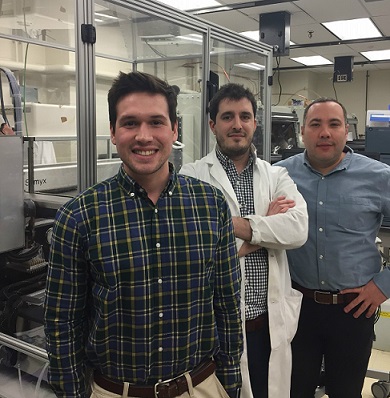
(From left) Kyle Smith, GR’23, lead author; Simon Berritt, director of Penn’s High Throughput Screening Center; and Daniel Mindiola, Presidential Term Professor of Chemistry.
Courtesy of University Communications
Wednesday, June 1, 2016
By Katherine Unger Baillie
Methane is the world’s most abundant hydrocarbon. It’s the major component of natural gas and shale gas and, when burned, is an effective fuel. But it’s also a major contributor to climate change, with 24 times greater potency as a greenhouse gas than carbon dioxide.
With a new method, a research team led by Daniel J. Mindiola, Presidential Term Professor of Chemistry, has demonstrated the potential to use methane not as a fossil fuel, but as a versatile chemical building block with which to make more complex molecules, such as pharmaceuticals and other value-added substances.
The reaction also offers a way of taking advantage of the properties of methane without releasing greenhouse gases.
“Finding ways to use methane besides burning it as a fuel constitutes a practical approach to using this abundant gas,” says Mindiola, senior author on the paper, published in the journal Science. “Our method will hopefully provide inspiration to move away from burning our resources and instead using them more as a carbon building block to prepare more valuable materials.”
Methane comprises a carbon atom bonded to four hydrogen atoms. When burned, all four carbon-hydrogen bonds break, resulting in the production of carbon dioxide and water, both of which are greenhouse gases.
Selectively breaking just one or two of those carbon-hydrogen bonds—which could allow for the synthesis of larger hydrocarbons—has been difficult, however. Chemists have therefore considered methane relatively inert unless burned. In addition, because methane is a gas at ambient temperatures and pressures, it can be difficult to manipulate.
But Mindiola had a brainstorm: What if he tried a borylation reaction using methane while varying pressure conditions? Carbon-hydrogen borylation is a process in which a hydrocarbon reacts with a boron-containing compound, catalyzed by a metal. The result is the replacement of a carbon-hydrogen bond with a carbon-boron bond. This bond can then be easily swapped to bond the carbon to another chemical group. Though borylation was discovered more
than a decade ago, no one had tried it using methane, the simplest of hydrocarbons.
Mindiola’s team decided to try. They searched the literature to identify a promising combination of compounds and catalysts, then used a computational approach to evaluate which conditions and reagents might improve the reaction’s efficiency.
Finally, they used Penn’s High Throughput Screening Center, which allows for the testing of 96 different reactions at once, to identify the most efficient conditions for the reaction.
The most favorable reaction, conducted under relatively mild conditions of 150 degrees Celsius and 500 pounds per square inch of methane, using the metal iridium as a catalyst, resulted in yields as high as 52 percent borylated methane with high selectivity for the carbon-hydrogen borylation of one C-H bond as opposed to multiple bonds.
“It turns out methane is not as inert as one would have expected,” Mindiola says. “We were able to borylate it using off-the-shelf reagents, which is very convenient.”
Methane is currently so abundant that the petrochemical industry burns upwards of $50 million of methane each year in gas flares, in part due to a lack of storage capacity. And while some methane is used for steam reforming, a process that forms carbon monoxide and hydrogen that can be used in fuel cells or to make ammonia for fertilizers, the researchers believe the borylation reaction can offer a meaningful alternative use for methane.
“I think this work is going to inspire a lot of chemistry and get people thinking about methane in a different way,” Mindiola says.